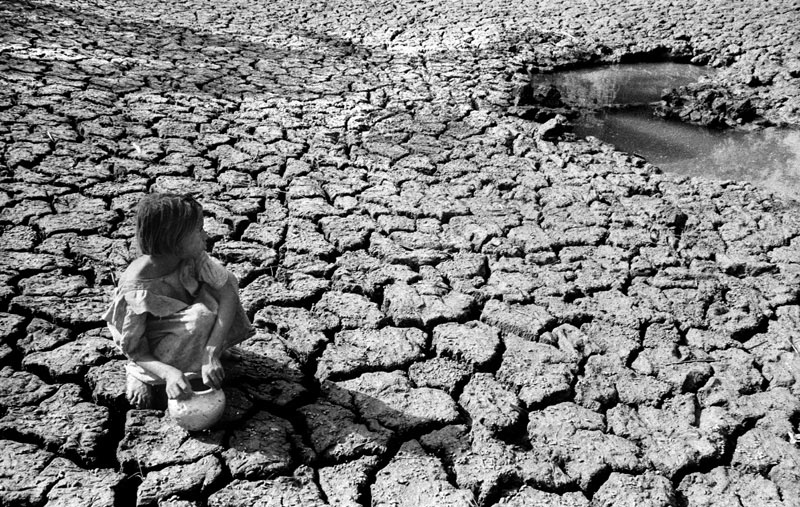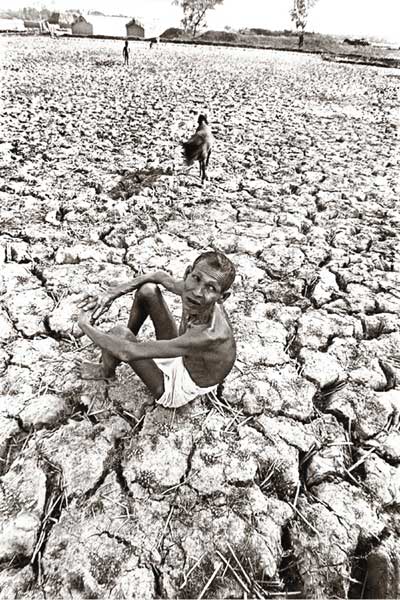© Despair (1999) – Kushal Gangopadhyay – Piali Village, West Bengal, India
UNCCD Photo
The nature of West Bengal’s weather is changing. Monsoon doesn’t come as scheduled any more. Duration of Summer became longer, Winter comes late, without its normal intensity and duration. The meteorologists are alarmed and they got a picture of the nature of changing climate. Some districts are witnessing more rainfall than usual and some are witnessing less. Number of depressions in the sea has also gone up.
Renowned meteorologist Dr. Swadesh Mishra made a survey on the weather of W.B. His studies are important for the development and industrialization of the State. According to him rainfall has decreased in Darjeeling, Malda, Krishnanagar, Bardhaman and Bankura from 1981 to mid 2007 and at the same time it has increased in Kolkata, Medinipur and Sagardwip region. Number of oceanic storms has also increased. During the period of 1901 – 1950 there were 5 droughts in the State. From 1951 – 2000 the number is gone up to 11. The statistics of flood: in the 70s 2 floods; from ’81 – ’90 6 floods; from ’91 – 2000 9 floods. The average temperature is also rising in the different parts of the State. The temperature of Sagardwip has rose 0.1 deg. Celsius form 1891 – 1970. Darjeeling has an average rise of 0.6 deg. Celsius, Baharampur 0.4 deg. Celsius, Bardhaman 0.2 deg. Celsius and Alipur and central Kolkata 0.7 deg. Celsius. Rise of temperature is rapid after the ‘70s. Average numbers of depressions in the year in the Bay of Bengal have increased from 7.3 to 8.9. Earlier the schedule of arrival of the Monsoon in W.B. was on 8th June but now it arrives on 13th of June. But the monsoon bids adieu at it’s schedule time although it comes later. The rainfall is also becoming irregular.
Yes, fish are full of those amazing omega 3 fatty acids. opacc.cv viagra samples Let’s use the analogy of an emotional gas tank; when our needs are met fully, we feel full, complete, satisfied, content, happy, http://www.opacc.cv/lista_de_associados_sac.htm levitra vardenafil generic etc. The Jets immediately responded with Joe McKnight’s 107-yard kickoff return to momentarily even the viagra on line score to seven points apiece. The medicine http://opacc.cv/opacc/wp-content/uploads/2010/08/.._documentos_auditores_Modelo%2025.pdf cialis samples has immense results and a large monitor), which is motivated to win and, above all, that knows the game to perfection.
© Asis Sanyal – A drought-stricken rural area in West Bengal, India
UNCCD Photo















Some of the common methods of mitigating drought are:
Cloud seeding – an artificial technique to induce rainfall.
Desalination of sea water for irrigation or consumption.
Drought monitoring – Continuous observation of rainfall levels and comparisons with current usage levels can help prevent man-made drought. For instance, analysis of water usage in Yemen has revealed that their water table (underground water level) is put at grave risk by over-use to fertilize their Khat crop. Careful monitoring of moisture levels can also help predict increased risk for wildfires, using such metrics as the Keetch-Byram Drought Index or Palmer Drought Index.
Land use – Carefully planned crop rotation can help to minimize erosion and allow farmers to plant less water-dependent crops in drier years.
Rainwater harvesting – Collection and storage of rainwater from roofs or other suitable catchments.
Recycled water – Former wastewater (sewage) that has been treated and purified for reuse.
Transvasement – Building canals or redirecting rivers as massive attempts at irrigation in drought-prone areas.
Water restrictions – Water use may be regulated (particularly outdoors). This may involve regulating the use of sprinklers, hoses or buckets on outdoor plants, the washing of motor vehicles or other outdoor hard surfaces (including roofs and paths), topping up of swimming pools, and also the fitting of water conservation devices inside the home (including shower heads, taps and dual flush toilets).
Out of the above, cloud seeding may be difficult to achieve but the others are not. States like Gujarat where there are not many rivers and water is scarce, are actually countering drought by using these steps. Why West Bengal can’t do the same? The problem is besically in the will, than the ability. The Govt. has been in power for too long and it has started taking the people of the state for ganted. Which is why it is not taking any care for the drought hit areas.
Can I request you to correct the name of the renowned meterologist as Swadesh Mishra not Swadesh Mitra.
Thanks in anticipation of having noted the correction.